Input interpretation

H_2O water + SF_4 sulfur tetrafluoride ⟶ SO_2 sulfur dioxide + HF hydrogen fluoride
Balanced equation
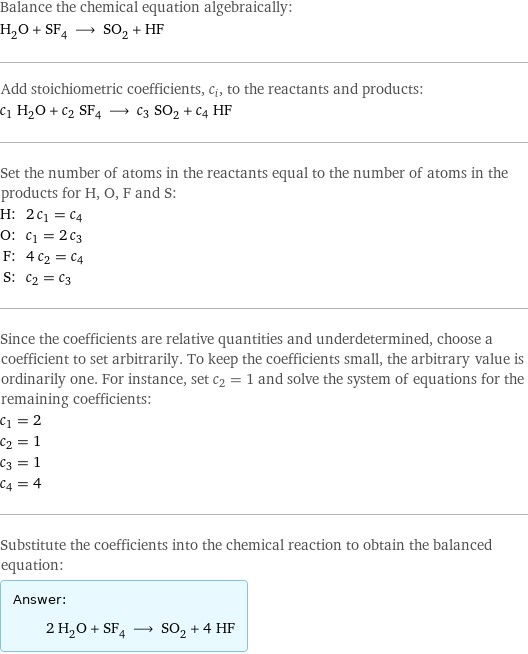
Balance the chemical equation algebraically: H_2O + SF_4 ⟶ SO_2 + HF Add stoichiometric coefficients, c_i, to the reactants and products: c_1 H_2O + c_2 SF_4 ⟶ c_3 SO_2 + c_4 HF Set the number of atoms in the reactants equal to the number of atoms in the products for H, O, F and S: H: | 2 c_1 = c_4 O: | c_1 = 2 c_3 F: | 4 c_2 = c_4 S: | c_2 = c_3 Since the coefficients are relative quantities and underdetermined, choose a coefficient to set arbitrarily. To keep the coefficients small, the arbitrary value is ordinarily one. For instance, set c_2 = 1 and solve the system of equations for the remaining coefficients: c_1 = 2 c_2 = 1 c_3 = 1 c_4 = 4 Substitute the coefficients into the chemical reaction to obtain the balanced equation: Answer: | | 2 H_2O + SF_4 ⟶ SO_2 + 4 HF
Structures
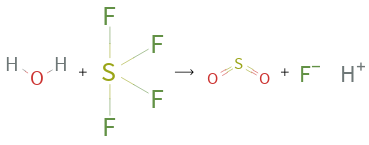
+ ⟶ +
Names

water + sulfur tetrafluoride ⟶ sulfur dioxide + hydrogen fluoride
Reaction thermodynamics
Enthalpy
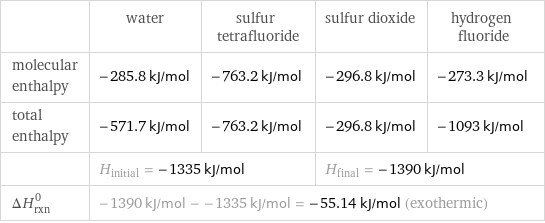
| water | sulfur tetrafluoride | sulfur dioxide | hydrogen fluoride molecular enthalpy | -285.8 kJ/mol | -763.2 kJ/mol | -296.8 kJ/mol | -273.3 kJ/mol total enthalpy | -571.7 kJ/mol | -763.2 kJ/mol | -296.8 kJ/mol | -1093 kJ/mol | H_initial = -1335 kJ/mol | | H_final = -1390 kJ/mol | ΔH_rxn^0 | -1390 kJ/mol - -1335 kJ/mol = -55.14 kJ/mol (exothermic) | | |
Gibbs free energy
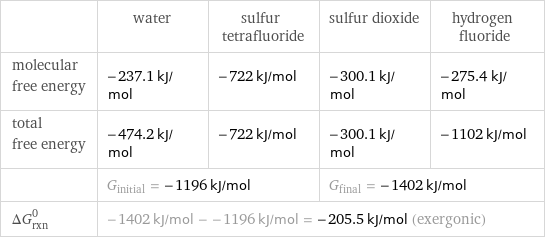
| water | sulfur tetrafluoride | sulfur dioxide | hydrogen fluoride molecular free energy | -237.1 kJ/mol | -722 kJ/mol | -300.1 kJ/mol | -275.4 kJ/mol total free energy | -474.2 kJ/mol | -722 kJ/mol | -300.1 kJ/mol | -1102 kJ/mol | G_initial = -1196 kJ/mol | | G_final = -1402 kJ/mol | ΔG_rxn^0 | -1402 kJ/mol - -1196 kJ/mol = -205.5 kJ/mol (exergonic) | | |
Equilibrium constant
![Construct the equilibrium constant, K, expression for: H_2O + SF_4 ⟶ SO_2 + HF Plan: • Balance the chemical equation. • Determine the stoichiometric numbers. • Assemble the activity expression for each chemical species. • Use the activity expressions to build the equilibrium constant expression. Write the balanced chemical equation: 2 H_2O + SF_4 ⟶ SO_2 + 4 HF Assign stoichiometric numbers, ν_i, using the stoichiometric coefficients, c_i, from the balanced chemical equation in the following manner: ν_i = -c_i for reactants and ν_i = c_i for products: chemical species | c_i | ν_i H_2O | 2 | -2 SF_4 | 1 | -1 SO_2 | 1 | 1 HF | 4 | 4 Assemble the activity expressions accounting for the state of matter and ν_i: chemical species | c_i | ν_i | activity expression H_2O | 2 | -2 | ([H2O])^(-2) SF_4 | 1 | -1 | ([SF4])^(-1) SO_2 | 1 | 1 | [SO2] HF | 4 | 4 | ([HF])^4 The equilibrium constant symbol in the concentration basis is: K_c Mulitply the activity expressions to arrive at the K_c expression: Answer: | | K_c = ([H2O])^(-2) ([SF4])^(-1) [SO2] ([HF])^4 = ([SO2] ([HF])^4)/(([H2O])^2 [SF4])](../image_source/9bd9d11e1812d40662ec01b8ccca3389.png)
Construct the equilibrium constant, K, expression for: H_2O + SF_4 ⟶ SO_2 + HF Plan: • Balance the chemical equation. • Determine the stoichiometric numbers. • Assemble the activity expression for each chemical species. • Use the activity expressions to build the equilibrium constant expression. Write the balanced chemical equation: 2 H_2O + SF_4 ⟶ SO_2 + 4 HF Assign stoichiometric numbers, ν_i, using the stoichiometric coefficients, c_i, from the balanced chemical equation in the following manner: ν_i = -c_i for reactants and ν_i = c_i for products: chemical species | c_i | ν_i H_2O | 2 | -2 SF_4 | 1 | -1 SO_2 | 1 | 1 HF | 4 | 4 Assemble the activity expressions accounting for the state of matter and ν_i: chemical species | c_i | ν_i | activity expression H_2O | 2 | -2 | ([H2O])^(-2) SF_4 | 1 | -1 | ([SF4])^(-1) SO_2 | 1 | 1 | [SO2] HF | 4 | 4 | ([HF])^4 The equilibrium constant symbol in the concentration basis is: K_c Mulitply the activity expressions to arrive at the K_c expression: Answer: | | K_c = ([H2O])^(-2) ([SF4])^(-1) [SO2] ([HF])^4 = ([SO2] ([HF])^4)/(([H2O])^2 [SF4])
Rate of reaction
![Construct the rate of reaction expression for: H_2O + SF_4 ⟶ SO_2 + HF Plan: • Balance the chemical equation. • Determine the stoichiometric numbers. • Assemble the rate term for each chemical species. • Write the rate of reaction expression. Write the balanced chemical equation: 2 H_2O + SF_4 ⟶ SO_2 + 4 HF Assign stoichiometric numbers, ν_i, using the stoichiometric coefficients, c_i, from the balanced chemical equation in the following manner: ν_i = -c_i for reactants and ν_i = c_i for products: chemical species | c_i | ν_i H_2O | 2 | -2 SF_4 | 1 | -1 SO_2 | 1 | 1 HF | 4 | 4 The rate term for each chemical species, B_i, is 1/ν_i(Δ[B_i])/(Δt) where [B_i] is the amount concentration and t is time: chemical species | c_i | ν_i | rate term H_2O | 2 | -2 | -1/2 (Δ[H2O])/(Δt) SF_4 | 1 | -1 | -(Δ[SF4])/(Δt) SO_2 | 1 | 1 | (Δ[SO2])/(Δt) HF | 4 | 4 | 1/4 (Δ[HF])/(Δt) (for infinitesimal rate of change, replace Δ with d) Set the rate terms equal to each other to arrive at the rate expression: Answer: | | rate = -1/2 (Δ[H2O])/(Δt) = -(Δ[SF4])/(Δt) = (Δ[SO2])/(Δt) = 1/4 (Δ[HF])/(Δt) (assuming constant volume and no accumulation of intermediates or side products)](../image_source/de1bbfa242d42f67c0fe65b61042f8f8.png)
Construct the rate of reaction expression for: H_2O + SF_4 ⟶ SO_2 + HF Plan: • Balance the chemical equation. • Determine the stoichiometric numbers. • Assemble the rate term for each chemical species. • Write the rate of reaction expression. Write the balanced chemical equation: 2 H_2O + SF_4 ⟶ SO_2 + 4 HF Assign stoichiometric numbers, ν_i, using the stoichiometric coefficients, c_i, from the balanced chemical equation in the following manner: ν_i = -c_i for reactants and ν_i = c_i for products: chemical species | c_i | ν_i H_2O | 2 | -2 SF_4 | 1 | -1 SO_2 | 1 | 1 HF | 4 | 4 The rate term for each chemical species, B_i, is 1/ν_i(Δ[B_i])/(Δt) where [B_i] is the amount concentration and t is time: chemical species | c_i | ν_i | rate term H_2O | 2 | -2 | -1/2 (Δ[H2O])/(Δt) SF_4 | 1 | -1 | -(Δ[SF4])/(Δt) SO_2 | 1 | 1 | (Δ[SO2])/(Δt) HF | 4 | 4 | 1/4 (Δ[HF])/(Δt) (for infinitesimal rate of change, replace Δ with d) Set the rate terms equal to each other to arrive at the rate expression: Answer: | | rate = -1/2 (Δ[H2O])/(Δt) = -(Δ[SF4])/(Δt) = (Δ[SO2])/(Δt) = 1/4 (Δ[HF])/(Δt) (assuming constant volume and no accumulation of intermediates or side products)
Chemical names and formulas

| water | sulfur tetrafluoride | sulfur dioxide | hydrogen fluoride formula | H_2O | SF_4 | SO_2 | HF Hill formula | H_2O | SF_4 | O_2S | FH name | water | sulfur tetrafluoride | sulfur dioxide | hydrogen fluoride
Substance properties
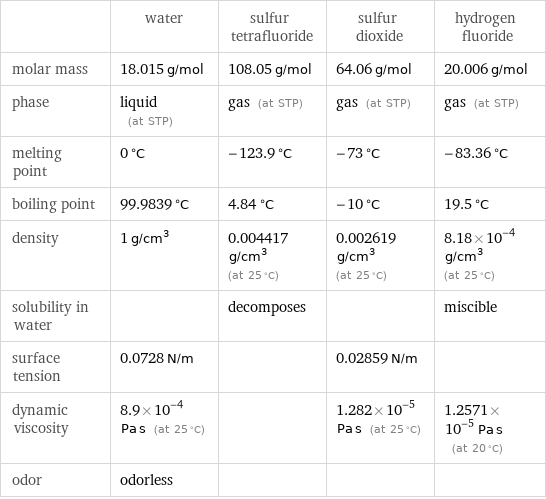
| water | sulfur tetrafluoride | sulfur dioxide | hydrogen fluoride molar mass | 18.015 g/mol | 108.05 g/mol | 64.06 g/mol | 20.006 g/mol phase | liquid (at STP) | gas (at STP) | gas (at STP) | gas (at STP) melting point | 0 °C | -123.9 °C | -73 °C | -83.36 °C boiling point | 99.9839 °C | 4.84 °C | -10 °C | 19.5 °C density | 1 g/cm^3 | 0.004417 g/cm^3 (at 25 °C) | 0.002619 g/cm^3 (at 25 °C) | 8.18×10^-4 g/cm^3 (at 25 °C) solubility in water | | decomposes | | miscible surface tension | 0.0728 N/m | | 0.02859 N/m | dynamic viscosity | 8.9×10^-4 Pa s (at 25 °C) | | 1.282×10^-5 Pa s (at 25 °C) | 1.2571×10^-5 Pa s (at 20 °C) odor | odorless | | |
Units
